Dr. Fred’s Annual Health Assessment of Uganda’s Gorillas
By Gorilla Doctors Staff on Friday, September 16th, 2011 in Uncategorized.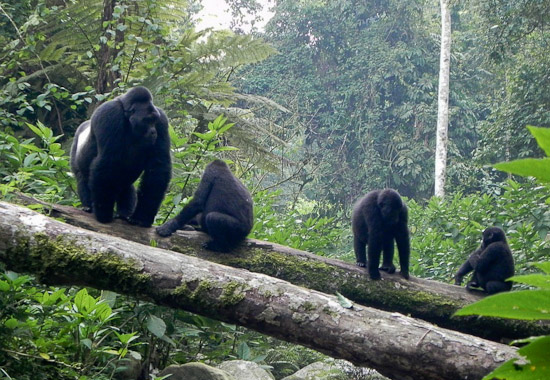 Mwirima with juveniles and infants crossing a water stream.Dr. Fred, MGVP’s Ugandan field veterinarian, offers his annual report on the health status of the habituated gorilla groups in Bwindi Impenetrable and Mgahinga National Parks.
Mwirima with juveniles and infants crossing a water stream.Dr. Fred, MGVP’s Ugandan field veterinarian, offers his annual report on the health status of the habituated gorilla groups in Bwindi Impenetrable and Mgahinga National Parks.
Rushegura Group
Rushegura is one of the biggest groups in Bwindi with 22 gorillas. The group is still under leadership of silverback Mwirima and his assistants blackbacks Kabukojo and Kalembezi. The gorillas range close to the Buhoma park headquarters and tourists camps.
Here is a summary of my visits with Rushegura this year:
- January 2011: Routine health monitoring of the gorillas; all were healthy.
- March 2011: Rushegura was healthy. An infant had been born to the group.
- May 2011: Several individuals were coughing during my visit. The coughing was loud, dry, and non-productive. No immediate treatment was necessary but I asked trackers to monitor the group carefully for any signs of deterioration.
- June 2011: All of the gorillas coughing last month were better except blackbacks Kabukojo and Kalembezi and a juvenile. Later their coughing cleared without treatment.
- August 2011: All gorillas were healthy on my recent visit. There was an adult female with a small swelling on her face but she was feeding normally. Monitoring continues.
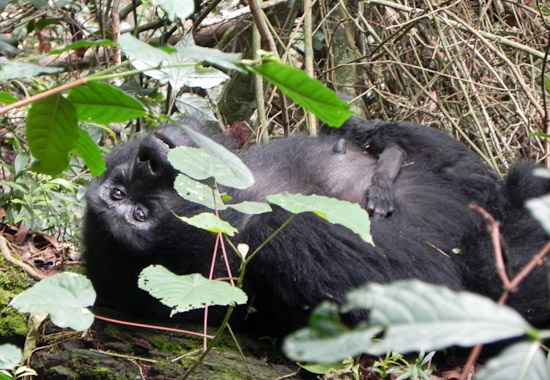 Rukundo resting while her newborn infant suckles.Habinyanja Group
Rukundo resting while her newborn infant suckles.Habinyanja Group
Habinyanja group ranges in the same area as Rushegura and Mubare groups and as well as several unhabituated solitary silverbacks. This area also has other primates like common chimpanzees, black and white colobus monkeys, I’hoest monkeys, red tailed monkeys, blue monkeys, and baboons. Elephants do also range in this area.
The group now has 17 members, having lost several members since the beginning of the year. In March, Habinyanga group interacted with Mubare group and the sub adult female Malaika returned to her former group of Mubare. In June, blackback Mizana was killed by poachers and another blackback named Maraya left the group of his own accord.
Here is a summary of my visits with Habinyanja this year:
- January 2011: Blackback Maraya had injuries due to intra-group fighting. The wounds were not very significant and so no treatment was given.
- March 2011: A juvenile identified as Hamusini was reported to be limping. On visiting I saw that the juvenile was slightly limping on the left hind limb but was feeding normally. No treatment was necessary.
- April 2011: The gorillas were all healthy.
- June 2011: Habinyanja moved and crossed the ‘neck’ of Bwindi towards Byumba. They had spent a long time without crossing to this part of the park. A blackback was killed by poachers in this area.
- August 2011: A second infant was born after another one born in July. I visited to check on the newborn infants and they were both healthy. They were suckling and their mothers, Rukundo and Nyamuhango, were lovingly carrying them.
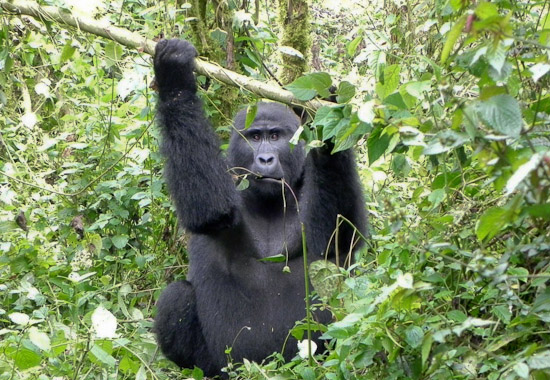 Blackback Kanyonyi.Mubare Group
Blackback Kanyonyi.Mubare Group
Mubare group is the oldest habituated group but remains the smallest with only 5 individuals. Sub adult female Malaika returned from Habinyanja group in March making the group 6 gorillas. However, in April female Kashundwe’s infant died and the body was not recovered for post-mortem. The cause of death was not established.
In June, July, and August, the group moved in two separate sub-groups with blackback Kanyonyi, Malaika, and sub adult male Muyambi staying together while the aging silverback Ruhondeza and Kashundwe moved separately. During August, the group had an interaction with Habinyanja and this may have had an impact on group cohesion.
Here is a summary of my visits with Mubare this year:
- January 2011: Kashundwe’s infant had wart-like growths on its face but these did not need immediate treatment.
- March 2011: The infant had no more warts.
- April 2011: Ruhondeza and Muyambi had injuries. Ruhondeza had an open wound on his left wrist. He was not using this hand well but the wound looked clean. He did not need treatment. Muyambi had a wound on his left hand but he used this hand well during feeding. He did not need treatment either. Kashundwe was suffering from the loss of her baby kept on hugging and wanting to carry sub adult female Malaika.
- June 2011: All of the individuals were healthy.
- August 2011: The group divided into 2 separate sub-groups and were not easy to locate.
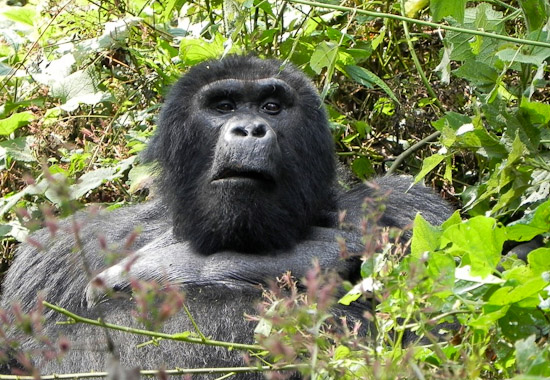 Karamuzi was recently injured.Bitukura Group
Karamuzi was recently injured.Bitukura Group
The group ranges on the Ruhija side of Bwindi. The members of Bitukura have been at odds with each other the past twos years and it has split and reunited several times. About 3 months ago, the group was united with 14 gorillas. However the four silverbacks started to fight again and also had an interaction with Kyaguliro group. Juvenile male Kabandize joined Kyaguliro group and silverback Rukumu led away 3 other males to form Rukumu group.
Silverback Ndahura remained the leader of the bigger Bitukura group with 9 gorillas. In August Rukumu and his followers rejoined Bitukura after an interaction. During these interactions, most of the silverbacks sustained injuries but they were not so big to warrant treatment. Only the old silverback Karamuzi received treatment after being reported with a necrotic wound.
Here is a summary of my visits with Bitukura this year:
- January 2011: I visited the group but only silverbacks Karamuzi, Rukara, and Rukumu were seen. All the silverbacks had healing wounds on their heads. On the 23rd I went to check on the juvenile male Kabandize, who was with Karamuzi. His right leg was hurt and he had he a patch on the leg without hair. He moved with a limp, as the leg could not bear pressure. He climbed a tree up and then down. The suspicion of a snakebite was tentatively ruled out by the type of limping and the absence of a bite wound.
- February 2011: I checked on Karamuzi, Rukara, Rukumu, and Kabandize again. The wounds had healed and Kabandize was healed also. The other members of Bitukura were ranging very far away.
- June 2011: The splinter group rejoined the main Bitukura group, which had a new infant. All of the gorillas were healthy.
- August 2011: I visited Bitukura group twice this month. I treated Karamuzi with antibiotics after he was seriously injured in a fight and I returned 3 days later to monitor the progress of the wound’s healing.
Oruzogo
This group was recently opened for tourism after a successful habituation process. It has 20 individuals and is led by silverback Tindikwata. Oruzogo group ranges on the Ruhija side of Bwindi in an area with many wild unhabituated gorilla groups.
Here is a summary of my visits with Oruzogo this year:
- February 2011: I visited the group when it was still under habituation. There were wounded individuals seen after an interaction with a wild non-habituated group. We encountered wild groups that chased this group away and we could not find them. Two days later, Oruzogo group was found and several gorillas were reported to have small wounds on their limbs.
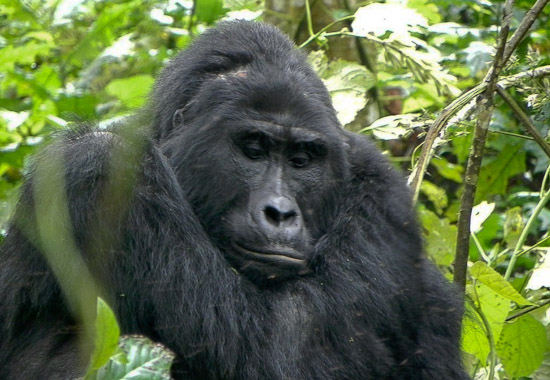 Bweza of Nshongi group with a healed head wound.Nshongi Group
Bweza of Nshongi group with a healed head wound.Nshongi Group
With 22 members, Nshongi remains the biggest habituated gorilla group in Bwindi. The group was originally 34 members, but silverback Mishaya left the group with 7 females and babies last year. The group is led by a silverback Nshongi. There are 3 other silverbacks in the group and there is frequent intra-group fighting especially when females come into estrus.
Here is a summary of my visits with Nshongi this year:
- January 2011: I visited the group to check on silverback Bweza who had been injured during a fight a month before. His wounds had healed well and the rest of the group was healthy.
- February 2011: I visited the group to check on female Bwiruka who had a wound on her forehead. The wound was about 2 cm by 3 cm and looked fresh. There was no indication of an infection. The rest of the gorillas were healthy.
- April 2011: I visited the group twice to check on several individuals who had been injured in a fight. These were adult female Nyampundu who had wounds on her shoulders and arms; blackback Mucunguzi who had a wound on left arm; silverback Kakono who had a slit wound on his head; and silverback Kutu who had a small wound on his left shoulder. The wounds were all clean and no signs of infection was observed. On my second visit, I saw that the wounds were healing well and the rest of the group was healthy.
- June 2011: I visited the group for routine health check and found that blackback Tinfayo had an open clean wound on his left thigh. The rest were healthy.
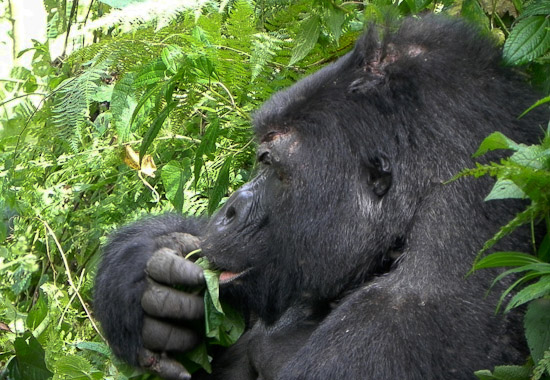 Mishaya with head wounds.Mishaya
Mishaya with head wounds.Mishaya
Mishaya group started the year on high note as dominant silverback Mishaya fought with other groups and took several new females for a total family size of 12 gorillas. However, Mishaya’s winning streak did not last. In April 2011, Mishaya was attacked by wild unhabituated gorillas. Mishaya himself and an infant were badly wounded in the fight. Mishaya had many wounds on the face, mouth, arms and legs. The infant had a big wound on the face. These were deep bite wounds.
In addition to the injuries, Mishaya group lost 5 individuals to the unhabituated group. In July, a new baby was born so now Mishaya has 8 gorillas.
Here is a summary of my visits with Mishaya this year:
- January 2011: I visited the group for routine health check and all the individuals were healthy. Some of the new members were still shy and kept hiding or moving away.
- April 2011: I visited for a routine health check, and the gorillas were all healthy. Later in the month, trackers reported the injuries to Mishaya and infant and so Drs. Magda and Noel and I went to check on them. The wounds looked ugly, but did not become infected, so no intervention was necessary.
- June 2011: I visited for a routine health check and all the gorillas were healthy.
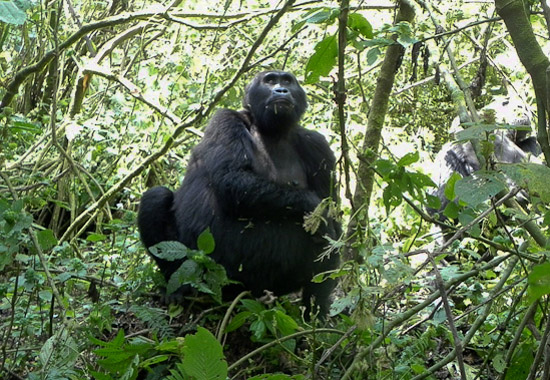 Female Kwitonda of Nkuringo looking healthy.Nkuringo Group
Female Kwitonda of Nkuringo looking healthy.Nkuringo Group
At the beginning of the year, there was a lot of intra-group fighting amongst the silverbacks competing for females and dominance. The number of silverbacks in the group had reached four including the leader Safari and Rafiki, Bahati, and Kirungi. There are two blackbacks, Posho and Karibu, and sub adult male Christmas was also becoming bigger and almost a blackback. Posho had been a victim of reprisals in the group and had had several wounds in the previous year.
In 2011, a number of adult females got involved in the fighting and in the process got injuries. One of them, Samehe, died. She received a serious head wound close to the brain that got infected. She was repeatedly treated for the months of February and March but she died on March 27.
One juvenile left the group to live a solitary life. This juvenile was seen once and is believed to be alive still. The group now has 17 gorillas.
Here is a summary of my visits with Nkuringo this year:
- January 2011: I visited for a routine health check and noted that Safari, Rafiki, and Kirungi had wounds but did not need treatment.
- February 2011: I visited the group early in the month to monitor the healing of the wounded silverbacks. On February 15, Samehe was reported with a severe injury on the head. Myself and Dr. Magda performed multiple interventions to treat the wound.
- March 2011: Samehe continued to receive multiple treatments but died on March 27. We performed a necropsy and buried her in the Nkuringo buffer zone.
- April 2011: I saw that Kasotora, Safari, Rafiki and Posho had wounds that were a result of intra-group fighting. The wounds were small and did not need treatment.
- May 2011: Posho had another wound on his thigh and Rafiki had scratch wounds all over his back. No treatment was necessary.
- June 2011: I visited the group after the report of a snared individual. The snare had been removed by the gorilla and there was a small wound on his toe where the snare had been. No treatment was given and the wound healed well.
- June 2011: The group was healthy.
Kahungye Group
Kahungye group is undergoing habituation in the southern sector of Bwindi. The group is named after the ranging area where they were first sighted. Habituation of the gorillas is almost complete and the gorillas are now tolerant of visitors within 10 meters. When I visited the group I saw that most of the juveniles were curious and the silverbacks were not very aggressive. One blackback and a silverback acted as sentries and could remain as close as 7 meters. The adult females were still shy and stayed close to the dominant silverback. The group composition is not yet clear but about 20 gorillas have been observed. The gorillas I observed looked healthy. Behaviorally, they still charged or chest beat when we moved closer than 10 meters.
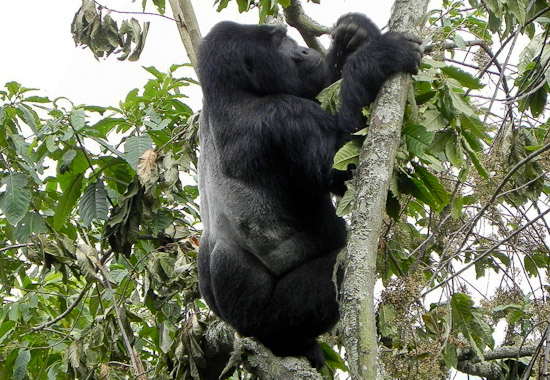 Rukina of Kyaguliro group in a tree.Kyaguliro Group
Rukina of Kyaguliro group in a tree.Kyaguliro Group
Kyaguliro group is a research group studied by the Institute of Tropical Forest Conservation. In 2011, Kyaguliro grew to 14 members after the birth of an infant and the addition of several new females from wild groups. However the baby died in January and in May juvenile Kabandize returned to his former family. Silverback Rukina is still the leader of the group assisted by blackback Mukiza.
Here is a summary of my visits with Kyaguliro this year:
- January 2011: I visited the group following reports of a newborn infant that was not well and later abandoned. I did not see the infant and we didn’t manage to get the body of the infant that we presumed dead. Mugwere, the mother of the infant, was fine. She was feeding well and well placed in the group.
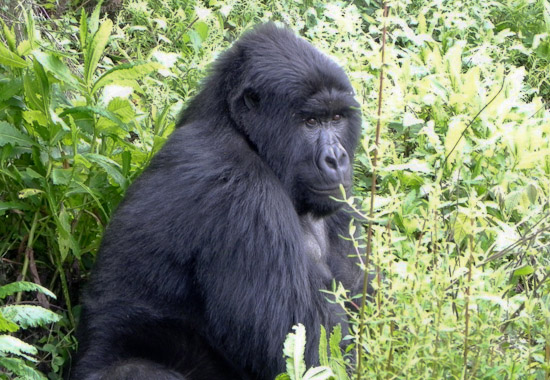 Rukundo of Nyakagezi looking very healthy.Nyakagezi Group
Rukundo of Nyakagezi looking very healthy.Nyakagezi Group
Nyakagezi group of Mgahinga National Park has one of the largest home ranges in the Virungas. The group occasionally ventures into neighboring Rwanda and the Democratic Republic of Congo. These gorillas enjoy a joint monitoring arrangement between the three range countries. The group is composed of 9 individuals including 3 silverbacks, 2 blackbacks, 2 adult females and 2 infants.
Here is a summary of my visits with Nyakagezi this year:
- January 2011: The gorillas were healthy and ranging on Muhabura volcano side.
- February 2011: The gorillas were healthy and ranging in Bisasa area on the Muhabura side.
- April 2011: The gorillas were healthy.
- June 2011: The gorillas crossed into Rwanda.
Please consider supporting MGVP by making a secure online donation. Every dollar you give goes to directly supporting our gorilla health programs and One Health initiative. Thank you for your generosity.
For the most up-to-date information about the Gorilla Doctors, “like” our Facebook page. You’ll find gorilla health reports, news items, photos, videos, and links to related content.


 Donate
Donate